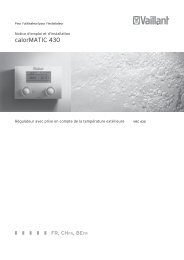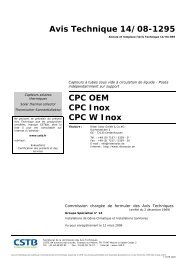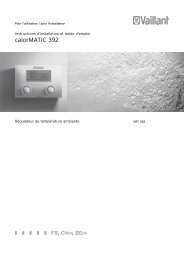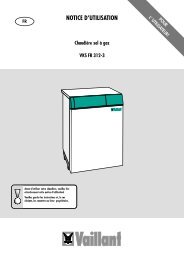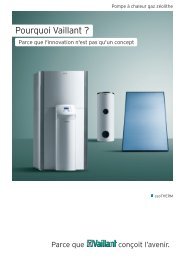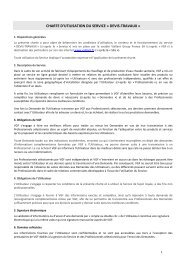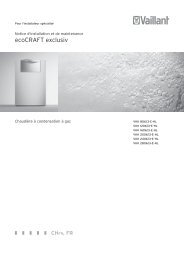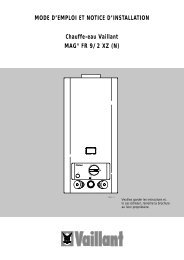vrc 410 bedienungs- und montageanleitung operating and ... - Vaillant
vrc 410 bedienungs- und montageanleitung operating and ... - Vaillant
vrc 410 bedienungs- und montageanleitung operating and ... - Vaillant
- No tags were found...
You also want an ePaper? Increase the reach of your titles
YUMPU automatically turns print PDFs into web optimized ePapers that Google loves.
DE GB FR<br />
Offset-Abschaltung<br />
Der Regler ist mit einer bedarfsabhängigen<br />
Heizungsabschaltung<br />
ausgestattet. Diese Funktion kann dann zu<br />
Problemen führen, wenn die Außentemperatur<br />
schnell ansteigt, die nach Norden<br />
gelegenen Räume aber noch kühl sind.<br />
Durch die Abschaltung würden diese Räume<br />
nicht mehr erwärmt.<br />
Um dieses Problem zu vermeiden kann für<br />
jeden Kreis ein Offset von 0°C bis 20°C<br />
eingegeben werden. In der Regel empfiehlt<br />
sich zusätzlich eine Fußpunktanhebung.<br />
Temperaturprofil<br />
Mit dieser Funktion wird ein Temperaturprofil<br />
durchlaufen, wie es z. B. zur Trocknung<br />
eines Estrichs eingesetzt wird. Die Vorlauftemperatur<br />
des Heizkreises wird automatisch<br />
auf die in Tabelle 6.2 angegebenen<br />
Temperaturen geregelt. Alle <strong>and</strong>eren Betriebsarten<br />
werden für die Dauer der Funktion<br />
unterdrückt. Beim Start der Funktion<br />
wird die aktuelle Uhrzeit als Startzeit gespeichert.<br />
Der Tageswechsel während des<br />
Programmablaufs erfolgt jeweils zu dieser<br />
Uhrzeit. Während die Funktion aktiv ist,<br />
werden im Display des Reglers der Betriebsmodus,<br />
der Tag <strong>und</strong> die Vorlaufsolltemperatur<br />
angezeigt.<br />
Wenn die Funktion wegen Netzausfall abgebrochen<br />
wurde, startet der Regler anschließend<br />
automatisch die Funktion mit<br />
dem 1. Tag (Zyklus 1). Wurde der 1.<br />
Zyklus vor dem Netzausfall bereits vollstän-<br />
Offset-cutoff (Temp. offset)<br />
The controller is fitted with a needdependent<br />
heating-system shutoff device.<br />
This function can give rise to problems if<br />
the external temperature rises fast but<br />
north-facing rooms nevertheless remain<br />
cold. System shutdown then leaves these<br />
rooms without heating.<br />
In order to avoid this problem, an offset<br />
of 0 °C to 20 °C can be entered for each<br />
circuit. It is normally advisable to to<br />
program in a low-point increase at the<br />
same time.<br />
Temperature profile<br />
With this function a temperature profile is<br />
passed through such as is used, for<br />
example, for drying flooring plaster. The<br />
flow temperature of the heating circuit is<br />
adjusted automatically to the temperatures<br />
shown in Table 6.2. All other <strong>operating</strong><br />
modes are suppressed for the duration of<br />
the function.<br />
At the start of the function the current time<br />
of the day is stored as the starting time. The<br />
change of day during the course of the<br />
program always takes place at this time.<br />
While the function is active, the <strong>operating</strong><br />
mode, the day <strong>and</strong> the required flow<br />
temperature are shown in the controller’s<br />
display.<br />
If the function has been interrupted due to a<br />
power failure, the controller then automatically<br />
starts the function with day 1 (cycle 1).<br />
If the 1st cycle has already been fully<br />
Déconnexion Offset<br />
La régulation est dotée d'une déconnexion<br />
de chauffage dépendant du besoin. Cette<br />
fonction peut poser problème qu<strong>and</strong> la<br />
température extérieure monte rapidement<br />
mais que les pièces situées au nord sont<br />
encore fraîches. Ces pièces ne seraient<br />
plus chauffées du fait de cette<br />
déconnexion.<br />
Pour remédier au problème, on peut entrer<br />
pour chaque circuit un Offset de 0 °C à<br />
20 °C. En général, il est recomm<strong>and</strong>é de<br />
faire un relevé de la base.<br />
Profil des températures<br />
Cette fonction permet de parcourir un profil<br />
des températures comme celui utilisé par<br />
exemple pour le séchage d’une aire en<br />
plâtre. La température d’amorçage du circuit<br />
de chauffage est réglée automatiquement<br />
sur les températures indiquées dans le<br />
tableau 6.2. Tous les autres modes sont<br />
impossibles pendant toute la durée de la<br />
fonction.<br />
Lors du démarrage de la fonction, l’heure<br />
actuelle est enregistrée comme heure de<br />
démarrage. Le changement de jour pendant<br />
l’exécution du programme se fait à chaque<br />
fois à cette heure. Tant que la fonction est<br />
activée, le mode de fonctionnement, le jour<br />
et la température théorique d’amorçage sont<br />
affichés sur l’écran du régulateur.<br />
Si la fonction a été interrompue en raison<br />
d’une panne de courant, le régulateur relance<br />
automatiquement la fonction au 1er jour<br />
43




